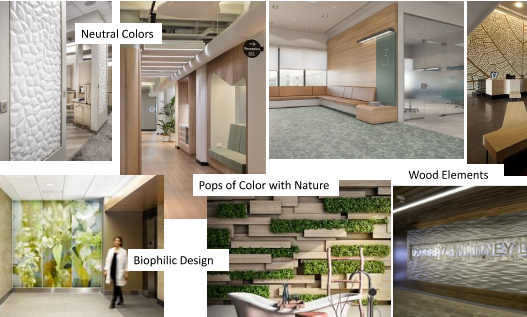Over the summer some of our team members attended NeoCon in Chicago, a conference that serves as a hub for the commercial design community. Designers, architects, clients, manufacturers, service providers, associations, educators all convene to hear about new products and trends, and gain design inspiration for current and future projects.
Our interior designer, Brittany Erskine, is back to talk about the biggest trends she learned about in interior design at NeoCon. (By the way, if you missed part I of this post, read it here!)
Natural Tones, Textures and Patterns
Although cool shades such as navy, gray and pure white aren’t out of style, designers are opting for natural, warm palettes these days to soften the touch of interiors.
“Humans feel more comfortable in settings that are full of warm, natural colors — [think] blues, greens, yellows and oranges,” explains Erskine.
Nature-influenced design reflects this trend as well because it’s full of organic shapes, naturalistic patterns and eye-pleasing tones.
“We see a lot of 1970s inspiration [with] touches of wood accents, use of natural light and stone, indoor/outdoor living and earth tones. [But], we are reworking the ’70s trends by infusing them with a modern look.”
Erskine names the “conversation pit,” commonly seen in ’70s design (think: a sunken living room), as a design touch that encouraged togetherness and collaboration. You won’t necessarily see that in an office environment today — but designers can play off of this concept by creating designated seating areas and pods so coworkers can gather in different spots within the same room. To infuse workspaces with design that encourages productivity, designers may select furnishings in natural shades (taupe, sage, sky blue) with organic lines, and design accents that mimic nature — think stone, leaf patterns and faux wood.
“Sketchworks has been using wood accents and natural colors in our projects,” notes Erskine. “This style of design is timeless and prevents our clients from needing to continuously update their spaces in the future.”
This trend goes hand-in-hand with biophilic design, explained below.
Biophilic Design
Stemming from a Greek word for “love of living things,” biophilic design is an evidence-based, revolutionary design movement that focuses on the human connection between nature and the built environment. It’s now widely accepted that our home and workspaces can significantly influence our physical and mental wellbeing.
“Bringing the outside in is a huge trend,” says Erskine. “Biophilic design is a concept used to increase the building occupants’ connectivity with nature within their environment, whether that’s through live plants and water features, or even water sounds and nature-inspired wallpaper.”
Indeed, this type of design supports cognitive function, health and psychological wellbeing, notes Erskine. “It also promotes wellness and productivity, which is crucial for commercial spaces.”
Thinking about incorporating this into your home or workspace? It can be as simple as picking up a few faux or real plants for your interiors. Or, paint your walls a soothing shade of mint or dusty blue.
“I’m excited for earth tones and soft color palettes that are being woven into spaces,” says Erskine. “[And] we are seeing some businesses creating fun spaces for employees to return back to the office.”


